We had thunder and lightening all night and woke to find ourselves in a quagmire of white mud. The day turned out to be warm and sunny however and by 10am we had gathered the soaking washing we'd left on the line overnight into a bucket and were on our way out of Pisa heading for Florence. The route was along a very unpleasant dual carriageway, full of potholes and heavy lorries.
We had rather foolishly decided to make for Fiesole on the hillside above Florence where we had details of a campsite that seemed to offer easy access to the city. Ian was keen to see the Roman and Etruscan remains here while Jill had pleasant memories of studying the poems of Robert Browning for A level literature. He visited here and wrote about Fiesole in at least one of his poems. We were foolish in that it is on the wrong side of Florence to reach easily from Pisa and we found ourselves unable to avoid driving right across the centre of Florence, a city of over half a million Italians, most of whom were in the centre of their city around lunchtime in cars, lorries, buses, vans, motorbikes, scooters, bicycles, or simply on foot. They knew where they were going. We didn't! Ian is very good at navigating our way out of nasty situations; Jill just wishes we didn't get into them in the first place! Really the very worst are the motor bikes and scooters. They lead charmed lives, weaving between tightly packed vehicles, nipping into the slightest gap left in the traffic. For us, just trying to find the right lane and stick with it was a nightmare. Vehicles simply stop and double park anywhere and nobody will every give way if you make a mistake and end in the wrong lane! The noise is frightening with horns sounding, people shouting and engines roaring as we are channelled into yet another railway underpass. The city is well named, Firenze in Italian. Jill was in quite a frenzy too by the time we found ourselves driving out of the city and up the steep green slopes of the hillside covered in cypress trees to Fiesole. The road climbed steeply, passing through the little town, continuing through streets becoming ever narrower and steeper until we reached the campsite on the crest of the hill with stunning views down onto Florence. The campsite is pleasant enough but is very expensive at 36 euros a night! You really get very little for your money but it's the only convenient location for Florence and the views are stupendous. The last part of the ascent is very steep indeed and the few vehicles that have made it up here are small camping cars. We have seen a French camping car stuck on the bend, too long to get around it, and a Danish caravan that has had to hire a Land Rover to get it up here when it too stuck on the bend.
So having hung out our wet washing again we walked the steep but scenic route back into Fiesole stopping to gaze at the splendour of Florence, dominated by the huge basilica of its cathedral, nestling in a wide hollow in the hills of the Tuscan countryside. From here Browning too looked down on the city. Jill cannot remember the details of the poem but remembers sniggering at the lines "…where white and wide, Florence lay stretched on the mountainside." Today those lines took on the meaning Browning intended. It really was a magnificent view.
 Florence from Fiesole
Florence from Fiesole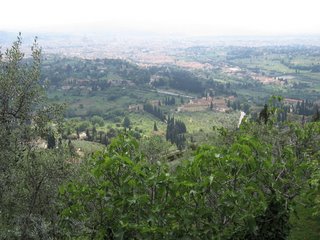 Florence from Fiesole
Florence from Fiesole Villa on the hillside of Fiesole
Villa on the hillside of FiesoleSoon we arrived at the centre of Fiesole, full of American and German tourists who had arrived from Florence on the bus to soak up the atmosphere of this supposedly peaceful little place. We spent the rest of the afternoon exploring the town, the 14th century Monastery of San Francesco which had so inspired the French writer Albert Camus as he sat in its peaceful cloistered garden after visiting the cells of the monks. We too rested there and peeped into the tiny bare cells where they would live and pray with just a wooden board to sleep on. One of the cells had been occupied by San Bernardino of Siena in the 14th century. The adjoining church had several beautiful 15th and 16th century paintings on its walls, which were also decorated with frescos.
 San Francesco's church, Fiesole
San Francesco's church, Fiesole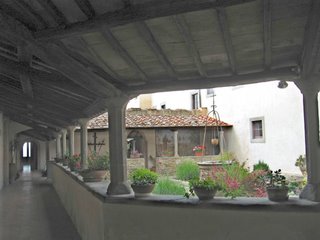 In a monastery garden, San Francesco, Fiesole
In a monastery garden, San Francesco, Fiesole San Bernardino's cell, San Francesco, Fiesole
San Bernardino's cell, San Francesco, FiesoleIn the centre of Fiesole we visited the eleventh century Cathedral, very austere and unadorned but with the beautifully executed late 15th century marble tomb of Bishop Salutati by Mino de Fiesole. Its square battlemented campanile dominates the town.
 Fiesole with the campanile of the Cathedral
Fiesole with the campanile of the Cathedral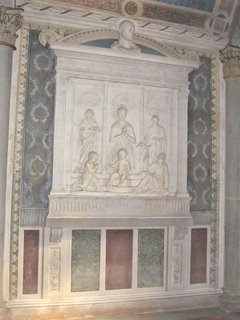 Tomb of Bishop Salutati in the Cathedral at Fiesole
Tomb of Bishop Salutati in the Cathedral at FiesoleFinally we visited the Archaeological Park with Roman theatre and baths. This landscaped complex looks down over the hillside and out across the bright green Tuscan hills scattered with tall, thin, dark green cypress trees. There are also the foundations of a Roman temple. The town was established in Etruscan times and in those early days was more important than nearby Florence. This was our first encounter with the mysterious Etruscans whose language has still to be deciphered although they used a version of the Greek alphabet. The Antiquarium attached to the site contained several of their funerary urns with recumbent figures and scenes of banqueting – they seem to have enjoyed the good life until the stern Romans put an end to it in the second century BC when they finally conquered them. There was also a wonderful display of Greek vases, the collection of Alfiero Costantini who had given them to the town.
 Roman theatre and Tuscan hills, Fiesole
Roman theatre and Tuscan hills, FiesoleThe little town only partially lived up to expectations. Some of the magic atmosphere that Browning, Shelley and others found was still there, but it was not helped by the fact that much of the centre was being redeveloped and traffic careered noisily down the narrow main street.
Exhausted we waited at the bus stop for the expected ride back up to the top of the hill and our campsite. When it arrived the bus turned out to be going a different route so we were left to struggle back on foot. Tonight we are feeling rather weary!
Friday 12th May 2006, Fiesole, Tuscany
Last night we slept solidly for nine hours! We woke to bright sunshine and the promise of a lovely day in Florence. We were not disappointed. Too impatient to wait for the bus down to Fiesole we walked in through the village streets with views across the surrounding countryside. It made quite a change to be wished Buon giorno as we passed, rather than the Guten Morgen we invariably receive on the campsite.
The bus ride down to Florence from Fiesole was quite an experience with us being hurled from side to side as we tore around the bends on the steep descent. Once down in the town we realised just what we had coped with yesterday crossing the city! It was a nightmare. How did we do it? Soon we were in a complete jam with traffic hooting on all sides as the driver tried to get the bus around a corner far too tight for it.
We abandoned the bus near the cathedral. The pictures will have to speak for themselves. We gazed in stunned awe at the Cathedral of Santa Maria del Fiore, started in 1296 and completed in 1434. Its dome by Brunelleschi is just slightly smaller than that of St. Paul's in London. The façade of the cathedral was extensively restored in the 19th century and never have we seen anything so ornate! Entirely decorated in different coloured stone and marble it is a riot of colour and pattern. The queues to see inside stretched right around the building and with so little time to spare we didn't bother joining the end of it. Beside it is the campanile designed by Giotto. It dates from 1330 and it too is decorated in bright elaborate marbles. Nearby stands the Romanesque baptistry. This is far more simple and is faced in green and white marble. Here the most important features are is the bronze doors, south door executed by Andrea Pisano in 1330. Everywhere was packed with tourists as one would expect. We discovered today just how useful a pair of binoculars can be for examining in detail the statues, carvings and decoration of the buildings from a distance without having to be squashed in with the immediate crowd. The finesse with which the works at roof level have been competed is just as detailed as at ground level.
 Baptistry, Cathedral and Campanile, Florence
Baptistry, Cathedral and Campanile, Florence Cathedral with Brunelleschi's dome, Florence
Cathedral with Brunelleschi's dome, Florence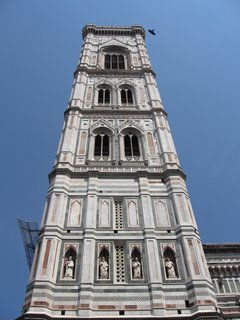 Cathedral campanile, Florence
Cathedral campanile, Florence Cathedral baptistry, Florence
Cathedral baptistry, Florence Restoring Matteo Rosselli's Gloria di San Carlo in the church of San Carlo dei Lombardi, Florence
Restoring Matteo Rosselli's Gloria di San Carlo in the church of San Carlo dei Lombardi, FlorenceWe strolled through the sunny streets, vibrant with activity, to the Piazza della Signoria dominated by the Palazzo Vecchio dating from the early 14th century along one side. Here we saw the Fountain of Neptune, 1576, and the equestrian statue of Cosimo the Younger.
 Palazzo Vecchio, Florence
Palazzo Vecchio, Florence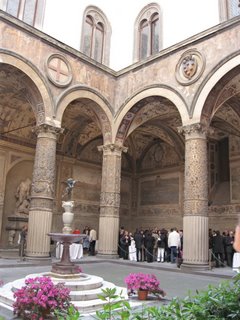 Courtyard of the Palazzo Vecchio, Florence
Courtyard of the Palazzo Vecchio, Florence Fountain of Neptune, Florence
Fountain of Neptune, Florence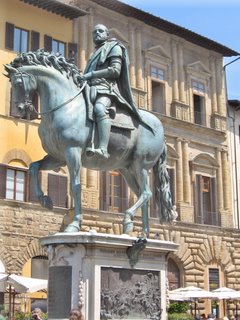 Cosimo the Younger, Florence
Cosimo the Younger, FlorenceHere too stands the Loggia dei Lanci dating from the late 14th century sheltering a collection of bronze and marble statues including a beautifully executed bronze of Perseus slaying Medusa by Benvenuto Cellini in1533. On the Piazza stands a marble copy of Michelangelo's David.
 Loggia dei Lanci, Florence
Loggia dei Lanci, Florence Perseus slaying Medusa, Florence
Perseus slaying Medusa, Florence Statue of David and the Piazzale degli Uffizi, Florence
Statue of David and the Piazzale degli Uffizi, FlorenceNearby in the Piazza is a plaque laid into the pavement marking the spot where the fanatical preacher Savonarola was burned at the stake in 1498.
 Plaque commemorating the death of Savonarola, Florence
Plaque commemorating the death of Savonarola, FlorenceOur plans to visit the famous Uffizi Museum were dashed when we saw the length of the queues to buy tickets. If we joined it we'd see nothing else at all. So we abandoned our plan and wandered down the arcaded Piazzale degli Uffizi, lined with its marble statues, to the 14th century Ponte Vecchio across the river Arno. This has houses and shops built across it. They are almost exclusively gold and silversmiths with spectacular window displays of elaborate Italian jewellery and have been there for centuries. Along one side of the bridge a gallery links the Uffizi and Pitti palaces.
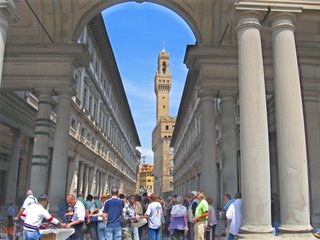 Piazzale degli Uffizi, Florence
Piazzale degli Uffizi, Florence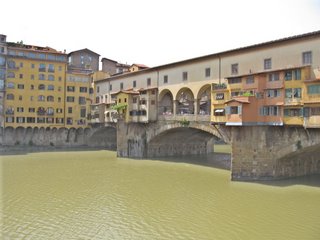 Ponte Vecchio across the river Arno, Florence
Ponte Vecchio across the river Arno, FlorenceBy this time we were hot, hungry and thirsty. Restaurants were all too expensive and there was nowhere to sit if we used a take-away sandwich bar. Eventually we found a little bar for a pizza and ice cold beer where we were able to rest for a while before rejoining the fray as we headed for the Pitti Palace, built in the late 15th century with the Boboli Gardens behind. Here the queues were much shorter, most tourists not bothering to go further than the end of the Ponte Vecchio. The next couple of hours were spent exploring the art and architecture of the Pitti Palace with its decorated and painted ceilings and its large, well proportioned rooms. During the Napoleonic occupation the palace was redecorated by Napoleon's sister and a bathroom made ready for him to wash his boney parts should he ever visit Florence. Ian was told off by one of the attendants for photographing this unusual relic of Napoleon's Italian adventures.
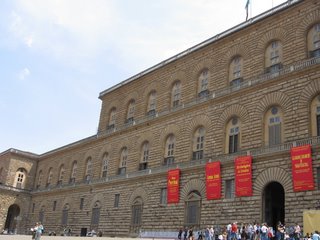 Pitti Palace, Florence
Pitti Palace, Florence Typical Italian bathroom without even a hook for Napoleon to hang his hat! Florence
Typical Italian bathroom without even a hook for Napoleon to hang his hat! FlorenceThe walls of the palace were hung with countless masterpieces by the great Italian artists – Botticelli, Raphael, Filipo Lippi, Andrea del Sarto, Tintoretto, to name a few. Regrettably after a while gazing at one religious scene after another it all becomes too much and we found ourselves wandering from room to room in a daze. The paintings were predominantly religious works by Italian artists but there were a number of works by other European painters including Peter Lely, Van Dyke, Ruebens, Velasquez and Murillo. On reflection later we realised we had not noticed a single crucifixion but hundreds of nativities. In Spanish galleries it had been the other way around. Is this a reflection of the artistic psyche of the two nations?
Exhausted after such a massive dose of culture we decided to treat ourselves to one of the highly acclaimed Italian ice-creams. There are gelaterias at every street corner with high mounds of ice cream of every hue and flavour imaginable in their windows. Naively we ordered a couple of cornets – tiramisu and chocolate. They were gigantic! So was the price! Still we have counted it as one of the special extravagant treats we were ordered to take on our travels, as a retirement present to Ian from Devon's local history societies! How to eat them before they melted! With rivulets of chocolate running down to our elbows we settled on the steps of the church of Santa Felicita licking happily as the pigeons gathered for any possible left-overs. Never before have we struggled to finish a cornet! By the time we'd sucked the final bits out the end of the cones we were covered in sticky brown gloop, the streets of Florence were paved with tiramisu and we were feeling slightly sick and vowing we'd never ever eat another one!
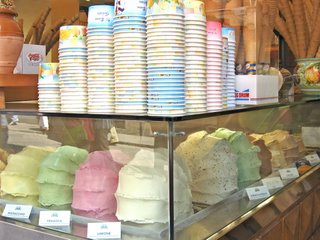 Italian ice cream, Florence
Italian ice cream, Florence Suck don't blow! Florence
Suck don't blow! FlorenceHeading back across the Piazza della Signoria on our way to the church of San Lorenzo we saw a huge overhead monitor displaying a live interview for Italian television that was taking place with various sports personalities in the square. On the screen just behind the interviewer could be seen a couple of sunburned British pensioners with rivulets of chocolate ice cream smeared down their trouser legs.
Unfortunately by the time we reached San Lorenzo and the adjoining Biblioteca Laurenziana they were both closed for the day. So we contented ourselves with a stroll around the peaceful cloisters of the church with its rose-filled garden before returning to catch the bus back up out of the city to Fiesole.
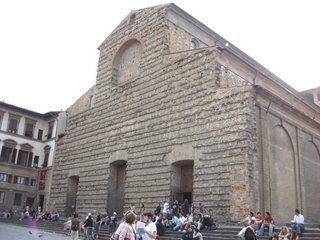 Church of San Lorenzo, Florence
Church of San Lorenzo, Florence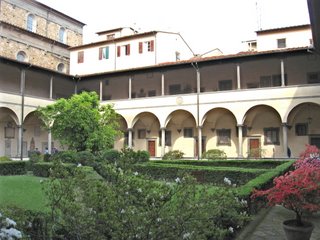 Biblioteca Laurenziana in the cloisters of San Lorenzo, Florence
Biblioteca Laurenziana in the cloisters of San Lorenzo, Florence